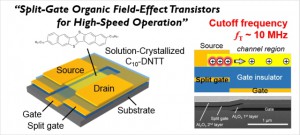Coexistence of ultra-long spin relaxation time and coherent charge transport in organic single-crystal semiconductors
Our paper “Coexistence of ultra-long spin relaxation time and coherent charge transport in organic single-crystal semiconductors” is available online in Nature Physics.
- Coexistence of ultra-long spin relaxation time and coherent charge transport in organic single-crystal semiconductors
Junto Tsurumi, Hiroyuki Matsui, Takayoshi Kubo, Roger Häusermann, Chikahiko Mitsui, Toshihiro Okamoto, Shun Watanabe* and Jun Takeya*
Nat. Phys. 13, 994-998 (2017).
DOI: 10.1038/nphys4217Abstract:
Coherent charge transport can occur in organic semiconductor crystals thanks to the highly periodic electrostatic potential—despite the weak van der Waals bonds. And as spin–orbit coupling is usually weak in organic materials, robust spin transport is expected, which is essential if they are to be exploited for spintronic applications. In such systems, momentum relaxation occurs via scattering events, which enables an intrinsic mobility to be defined for band-like charge transport, which is >10 cm2 V−1 s−1. In contrast, there are relatively few experimental studies of the intrinsic spin relaxation for organic band-transport systems. Here, we demonstrate that the intrinsic spin relaxation in organic semiconductors is also caused by scattering events, with much less frequency than the momentum relaxation. Magnetotransport measurements and electron spin resonance spectroscopy consistently show a linear relationship between the two relaxation times over a wide temperature range, clearly manifesting the Elliott–Yafet type of spin relaxation mechanism. The coexistence of an ultra-long spin lifetime of milliseconds and the coherent band-like transport, resulting in a micrometre-scale spin diffusion length, constitutes a key step towards realizing spintronic devices based on organic single crystals.

